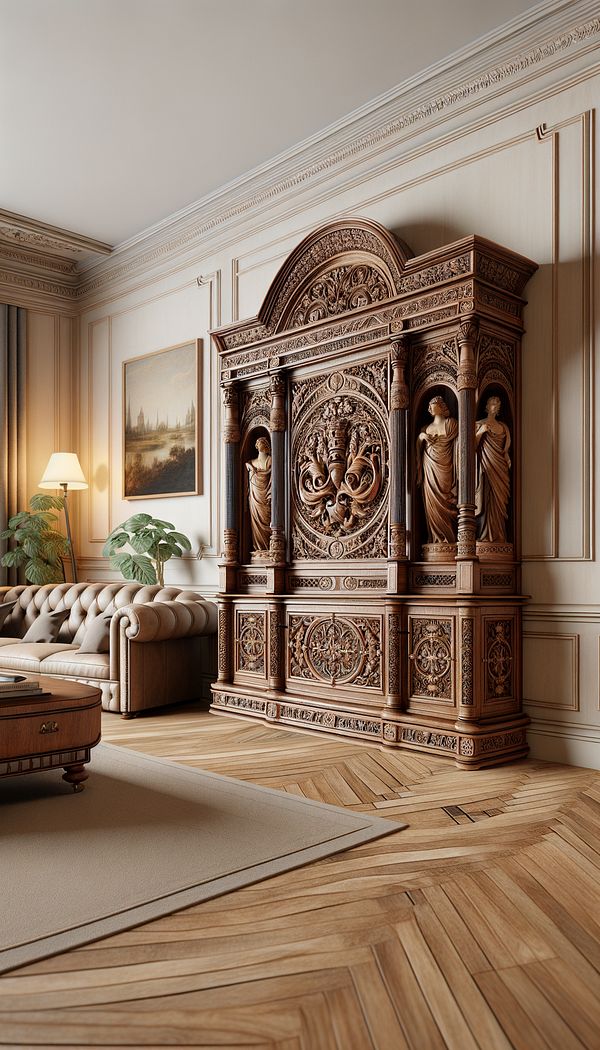What is a Court Cupboard?
A Court Cupboard is a type of wooden sideboard or cabinet.
Description
A Court Cupboard is an elegant piece of furniture that has its origins in the late Middle Ages and was especially popular until the 17th century. This form of furniture was originally designed to display the most prized possessions of a household, such as silverware and fine textiles, and served as a symbol of wealth and status. Typically crafted from wood, Court Cupboards often feature intricate carvings, mouldings, and ornamentation that reflect the design styles of their respective periods.
With its historical roots, a Court Cupboard can vary in design significantly, from early, more rustic versions to elaborately decorated pieces that might include details such as turned columns, heraldic symbols, or even religious motifs. These pieces not only served their practical purpose of storage but were also a focal point in a room, commanding attention and admiration.
In modern interior design, a Court Cupboard can be a statement piece that adds character and a touch of history to a space. Whether it's repurposed as a bar, used for display, or simply as storage, this piece of furniture brings a unique blend of functionality and aesthetics.
Usage
Originally, Court Cupboards were found in the grand homes of nobility and the wealthy, where they were used to display valuable possessions. Today, they can be found in a variety of settings, including historical homes, traditional and eclectic interiors, and as part of curated antique collections. Their ability to blend with different styles, from rustic to refined, makes them versatile additions to modern homes.
FAQs
-
How do Court Cupboards differ from regular cupboards?
Court Cupboards are distinct in their historical significance and decorative features, displaying intricate carvings and designs that regular cupboards typically lack. They also have a specific history of use for displaying precious items, unlike standard cupboards used for general storage.
-
Can a Court Cupboard be used in a contemporary setting?
Yes, when thoughtfully incorporated, a Court Cupboard can add a unique, historical element to contemporary settings. It can serve as a statement piece, offering both visual interest and functionality in modern interiors.
-
What materials are Court Cupboards made from?
Court Cupboards are predominantly made from wood, with oak being a common choice due to its durability and the beautiful patina it develops over time. Sometimes, exotic woods or inlays were used for additional decoration.
Practical Application
Integrating a Court Cupboard into your interior design can add a layer of historical charm and sophistication. Consider placing it in a prominent location, like the living room or dining area, where it can serve as a focal point. Use it to display cherished items or as an unusual storage solution, combining practicality with the inherent beauty and history of the piece. Proper lighting can further enhance its intricate details, celebrating its craftsmanship.
-
Furniture Types599 articles
-
Decorative Techniques322 articles
-
Historical Periods & Movements150 articles
-
Fabrication & Craftsmanship133 articles
-
Decorating Principles & Elements330 articles
-
VelvetVelvet is a luxurious fabric known for its soft, dense pile and distinctive sheen.
-
SeersuckerSeersucker is a puckered, lightweight fabric commonly used in a variety of interior design applications.
-
FrescoFresco is a technique of mural painting executed upon freshly laid wet plaster.
-
Drum TableA drum table is a round table with a cylindrical base, often featuring drawers and a tooled leather top.
-
Slip MatchSlip match is a method used to arrange wood veneer sheets in a panel.
